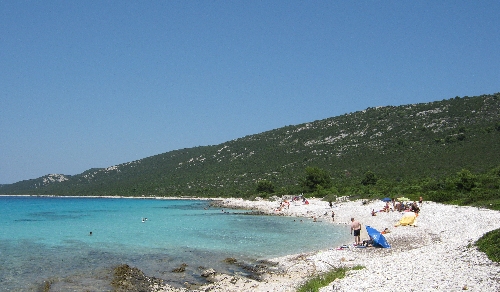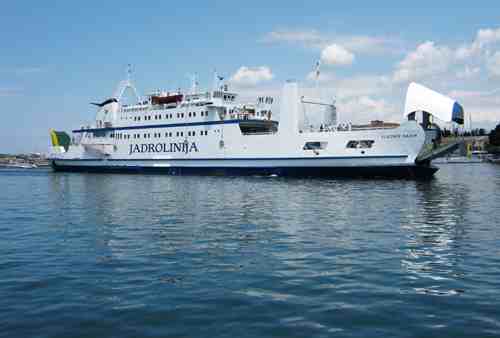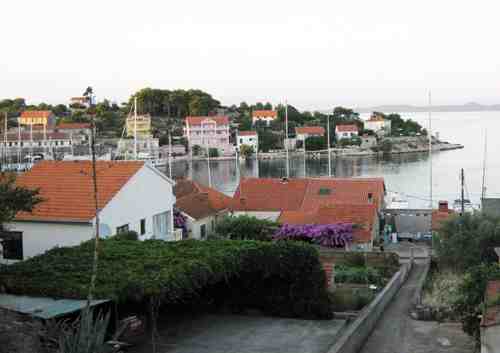






As elsewhere in Croatia, what is called ‘the beach’ on Dugi Otok isn’t what one normally would think of as a beach. There are no long stretches of sand gently sloping down into the sea. Instead, in each of the island’s coastal settlements, there are man-made places where it is possible to enter the sea and swim and sunbathe on the shore.

The two pictures on the left are of our nearest ‘beach’ in Sali, about ten minutes walk from the apartment. They illustrate what I mean by ‘the beach’ being man-made. The handrails do make entering the sea that bit easier and the sea itself was very pleasantly warm. However, there is no chance to gently wade in as the sea-bottom drops away quite steeply. This part of ‘the beach’ is quite shaded but the pier provides plenty of space for sun worshippers.
Similar ‘beaches’ to this can be found in all the island settlements along the sheltered east coast of Dugi Otok. There are no settlements at all on the more exposed west coast. But in a couple of places, a steep minor road leaves the main north-south road and descends to the shore. One leads to a place called Mala Voda which literally translates as ‘little water’. I say ‘place’ but there are no buildings other than a wooden shack – just an area for car parking together with a tiny harbour where small boats can be launched.

It is then possible to walk 300-400 metres north from the car park, either along the pebbly shoreline or on a parallel path through the ‘maquis’ and reach a place that more resembles what I understand as a beach! Whilst the area above sea level is made up entirely of pebbles, as soon as one enters the sea there is sand under foot. And here it is possible to gently wade some way into the sea before being out of one’s depth.

Mala Voda became our favourite beach during our ten days on Dugi Otok. It was never crowded, no doubt because it takes a little more effort to reach it, and always felt very relaxed. In many respects it is the perfect beach for children as access to the sea is so much easier than on the man-made ‘beaches’. But we saw very few children almost certainly because of the greater effort needed to reach the beach. It has no shade so we always took our beach umbrella and often went in the late afternoon when the angle of the sun was lower.
If we return to Dugi Otok sometime in the future, which I hope we will, one thing I shall certainly look forward to doing is swimming in the sea again from the beach at Mala Voda.


Officially, if you stay overnight somewhere in Croatia, your presence needs to be registered with the authorities. Therefore we had to give our passports to Darinka, the owner of the apartment, so she could take them back down to the Tourist Office and register the fact that we would be temporarily resident in her apartment for the next ten days.
When our passports were returned, inside each of them was an official slip of paper. Both slips were entitled in ‘Crenglish’, (a language very similar to ‘Czenglish’), ‘Temporary of Permanent Residence’!! But apart from that, the one issued for Sybille was completely accurate. However, when we examined my ‘Temporary of Permanent Residence’, we descended into howls of laughter. Whilst they had got the day & month of my birth correct, they had put my year of birth down as 1985 thus making me only 24 years old! Overnight, Croatian bureaucracy had taken 33 years off my age and given me back my youth.
But whilst I was pleased with being made many years younger, I did not appreciate what else they had done. My country of birth was stated as ‘Njemacka’, the Croatian name for Germany. Croatian bureaucracy had turned me into a German!!!!!!
Eventually we decided that it wasn’t worth the hassle to go down to the Tourist Office ourselves and point out their error. Instead, Sybille just enjoyed being married to a young 24 year old fellow-countryman for the following ten days!

Having arrived in Zadar on the afternoon of Tuesday 7th July, we decided that now was the time to head for an offshore island for the time of relaxation that we had promised ourselves. We found the booking office of Jadrolinija Ferries on the Zadar quayside and enquired about booking a ferry crossing for ourselves and the car for the following day to the island of Dugi Otok.
There are more than a thousand islands along the Croatian coast of which more than one hundred are inhabited. Some are so close to the mainland that they are connected by a bridge, whilst others are so small and isolated you would have to take everything needed for your stay with you. We opted for the island of Dugi Otok because it fell into neither of these categories. It takes a one and a half hour ferry journey to reach the island from Zadar but has a resident population of 1800 people and therefore has most basic shops and facilities.
The name ‘Dugi Otok’ means ‘Long Island’, which is most appropriate as it is around 43km long but only 4km wide. When driving along the one main road that links Veli Rat and Bozava in the north to Sali in the south, there are places where you can view the sea on both sides at the same time. On the west coast is the full expanse of the Adriatic Sea stretching all the way to Italy. From the east coast, the Croatian mainland is visible, with several parallel smaller islands in between.
Just before midday on Wednesday 8th, we joined the line of cars on the designated section of the quayside, ready to board the ferry. We waited for and then watched its arrival as the bow section rose and the access ramp was lowered. Once the cars and passengers travelling from the island to the mainland had disembarked, we were then summoned forward to carefully drive onto the car deck. Then the ramp was raised, the bow lowered and we headed off out of the harbour, bound for Dugi Otok.

The ferry port on Dugi Otok is at Brbinj, just over halfway up the east coast of the island. From there it took us about thirty minutes to drive south to Sali, the administrative centre and by far the largest settlement on Dugi Otok. We parked on the quayside of the picturesque harbour and walked along to find the tourist office to see if they could help find a one bedroomed apartment for us to rent for the next ten days. The young lady in the tourist office assured us that she could and, after a brief phone conversation in Croatian, told us that an owner would be with us in less than ten minutes to show us one. It was within my price range, had the basic requirements we were after, as well as a splendid view from the balcony across the harbour. We took it!

One of the reasons we took the risk of setting out on holiday with no accommodation booked in advance, was because we expected the current economic downturn would reduce the number of tourists meaning that, even in July, places would hopefully, not be fully booked. And so it has proved to be. Our apartment is in a building consisting of four separate apartments. When we arrived, none of the other three were let. Likewise, the ferry car deck was only two thirds occupied. Whilst Sali is busy, especially in the evenings, clearly the tourist industry here in Croatia has also been affected by economic events elsewhere in the world.

Zadar is the largest city on the north Dalmatian coast with a population of around 70,000. Its historic centre lies on a peninsular only 500m wide with a Roman street pattern containing marble paved traffic-free streets and a wealth of Roman remains and historic buildings. Chief amongst these is St. Donat’s Church, an amazing circular building which dates from the beginning of the ninth century.
Although located in Western (Roman Catholic) Europe, the Church is of early Byzantine (Eastern Orthodox) style. What makes it even more fascinating is that it was built over part of the Roman forum that dates from the 1st century BC to the 3rd century AD. Therefore, incorporated into the Church are two complete Roman pillars, together with other stonework containing Latin inscriptions. It is possible to climb a stone stairway to a first floor arcade and walk completely around in a circle looking down on the ground floor.
Outside of the Church, there are many more Roman remains including another pillar that was used as a ‘shame post’ during mediaeval times. It is ironic that some of these Roman remains were only discovered as a result of allied bombing during World War II which destroyed the more recent properties which had been built on top of them.
Walking around this fascinating city on a sunny Tuesday afternoon and Wednesday morning in July 2009, it was hard to believe that less than 18 years previously, it had once more been part of a war zone, under siege for three months from Serb gunners during the Croat – Serb war that resulted from the break-up of the former Yugoslavia. Now it is a bustling city, welcoming the visiting tourist and resident citizen alike and displaying a wealth of history stretching back more than 2000 years.